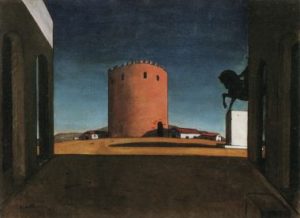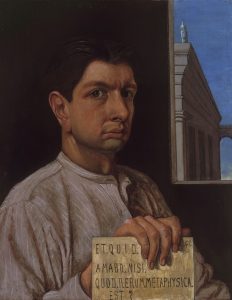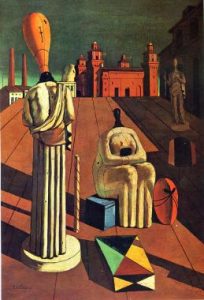Giorgio de Chirico was an Italian artist and writer born in Greece. In the years before World War I, he founded the art movement of the metaphysical school, which profoundly influenced surrealist artists.

Image source: https://en.wikipedia.org/wiki/Giorgio_de_Chirico#/media/File:The_Red_Tower_by_Giorgio_de_Chirico.jpg
Giorgio de Chirico was an Italian surrealist painter, born in Volos, Greece, whose work involved a metaphysical questioning of reality. His most famous works feature long shadows, Roman arches, trains, mannequins, and illogical perspectives. His imagery reflects his affinity for Nietzsche’s philosophy and the mythology of his birthplace.
Life and Education

De Chirico was the eldest son of Gemma Cervetto and Evaristo de Chirico, his mother was Genoese-Greek (probably born in Smyrna), and his father a Sicilian barone of remote Greek origin (the Kyriko or Chirico was a family of Greek origin who moved from Rhodes to Palermo in 1523, along with 4000 other Greek-Catholic families). At the time of De Chirico’s birth, the family was in Greece because his father, an engineer, was in charge of building a railway.
From 1900, de Chirico studied drawing and painting at the Athens Polytechnic—under the guidance of the Greek painters Georgios Roilos and Georgios Jakobides. After the death of his father in 1905, the family moved to Germany in 1906, after visiting Florence for the first time. De Chirico entered the Munich Academy of Fine Arts, where he studied with Gabriel von Hackl and Carl von Marr and read the writings of the philosophers Nietzsche, Arthur Schopenhauer, and Otto Weininger. There, he also studied the works of Arnold Böcklin and Max Klinger.
Metaphysical Art
In the summer of 1909, De Chirico returned to Italy and spent six months in Milan. In 1910 he began painting in a simpler style of flat, anonymous surfaces, and in the same year he moved to Florence where he painted the first series of his ‘Metaphysical Town Square’, and The Enigma of an Autumn Afternoon, following the revelation which he had in Piazza Santa Croce, also in Florence, he painted The Enigma of the Oracle. In July 1911 he spent a few days in Turin and De Chirico was deeply moved by what he called the ‘metaphysical aspect’ of Turin, in particular the architecture of its arches and squares.

De Chirico’s paintings produced between 1909 and 1919, his metaphysical period, are characterized by disturbing and gloomy moods evoked by their images. At the beginning of this period, his subjects were motionless cityscapes inspired by the bright daylight of Mediterranean cities, but he gradually turned his attention to studies of messy warehouses, sometimes inhabited by hybrid mannequin-like figures.
Where His Inspiration Came From?

Image source: https://en.wikipedia.org/wiki/Giorgio_de_Chirico#/media/File:The_Disquieting_Muses.jpg
De Chirico’s conception of Metaphysical art was influenced by his reading of Nietzsche, who fascinated de Chirico with its suggestions of auspices invisible under the appearance of things. De Chirico found inspiration in the unexpected sensations that familiar places or things sometimes produced in him. What is required above all is a marked sensitivity. Metaphysical art intertwined everyday reality with mythology evoking inexplicable moods of nostalgia, tense waiting, and estrangement. The space of the image often presented illogical, contradictory, and drastically elusive perspectives. Among the most frequent motifs of de Chirico were arcades, of which he wrote: “The Roman portico is destiny… its voice speaks in enigmas that are full of typically Roman poetry“.
Return to Order
In November 1919, de Chirico published in Valori plastici an article entitled “The Return of Craftsmanship”, in which he hoped for a return to traditional methods and iconography. This article marked an abrupt change in his artistic orientation, as he adopted a classicist manner inspired by ancient masters such as Raphael and Signorelli, and became part of the return to order in the arts in the postwar period. He became an outspoken opponent of modern art.
Later Years
In 1939, he adopted a neo-Baroque style influenced by Rubens, however, De Chirico’s later paintings never received the same critical praise as those of his metaphysical period. He resented this, as he felt his later work was better and more mature. However, he produced backdated “self-forgeries” both to profit from his previous success and as an act of revenge, a punishment for critics’ preference for his early works. He also denounced many paintings attributed to him in public and private collections as fakes.

Image source: https://search.creativecommons.org/photos/46ef630d-7ec3-40d9-b1d8-d11b46f1fd03
Info sources:
https://en.wikipedia.org/wiki/Giorgio_de_Chirico
https://www.wikiart.org/en/giorgio-de-chirico
